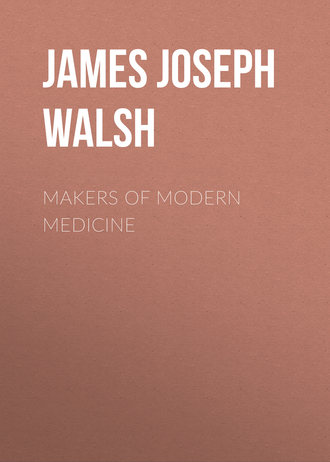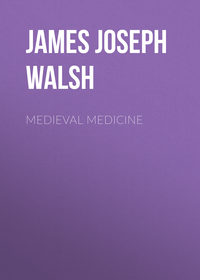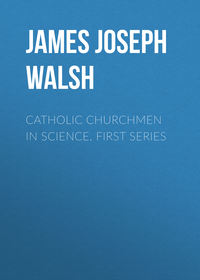 полная версия
полная версияПолная версия
Makers of Modern Medicine
These tributes to Laennec, however, from men who were his contemporaries across the channel, have been more than equalled by distinguished physicians on both sides of the Atlantic at the end of the nineteenth and the beginning of the twentieth century. While we might hesitate to accept the opinions of those who had been so close to him at the beginning of the new era of physical diagnosis, there can be no doubt now, after the lapse of three-quarters of a century, of what Laennec's influence really was, and the tributes of the twentieth century place him among the few great geniuses to whom scientific medicine owes its most important advance.
At the annual meeting of the State Medical Society of New York held in Albany at the end of January, 1903, the president of the society, Doctor Henry L. Elsner, of Syracuse, in his annual address devoted some paragraphs to a panegyric of Laennec. He wished to call attention to what had been accomplished for scientific medicine at the beginning of the last century by a simple observant practitioner. In the course of his references to Laennec and his work he said:
"It is by no means to be considered an accident that, among the greatest advances in medicine made during the century just closed, the introduction of pathological anatomy and auscultation into the practice of medicine at the bedside were both effected by the same clear mind, Laennec. He is one of the greatest physicians of all time."
He then quoted the opinion of a distinguished English clinician, Professor T. Clifford Allbutt, who is well known, especially for his knowledge of the history of medicine. Professor Allbutt is the Regius Professor of Physic (a term about equivalent to our practice of medicine) of Cambridge University, England, and was invited to this country some years ago as the representative of English medicine to deliver the Lane lectures in San Francisco. During his stay in this country he delivered a lecture at Johns Hopkins University on "Medicine in the Nineteenth Century," in which he said, "Laennec gives me the impression of being one of the greatest physicians in history; one who deserves to stand by the side of Hippocrates and Galen, Harvey and Sydenham. Without the advances of pathology Laennec's work could not have been done; it was a revelation of the anatomy of the internal organs during the life of the patient."
René Theodore Hyacinthe Laennec, who is thus conceded by twentieth century medicine a place among the world's greatest medical discoverers, was born February 17, 1781, at Quimper in Bretagne, that rocky province at the north of France which has been the sturdy nursing mother of so many pure Celtic Frenchmen who have so mightily influenced the thought not only of their own country but of all the world. The names of such Bretons as Renan and Lamennais have a universal reputation and the province was even more distinguished for its scientists.
There was published2 a few years ago in France a detailed history of Breton physicians. This work sketches the lives of the physicians of Breton birth from the sixteenth to the twentieth century. Only those of the nineteenth century concern us, but the list even for this single century includes such distinguished names as Broussais, whose ideas in physiology dominated medicine for nearly the whole of the first half of the nineteenth century; Jobert, the famous French surgeon whose reputation was world-wide; Alphonse Guerin, another distinguished surgeon, whose work in the protection of wounds in some respects anticipated that of Lister; Chassaignac, to whose inventive genius surgery owes new means of preventing hemorrhage and purulent infection, and who introduced the great principle of surgical drainage; finally Maisonneuve, almost a contemporary, whose name is a household word to the surgeons of the present generation; without mentioning for the moment the subject of this sketch, Laennec, the greatest of them all. Six greater men never came from one province in the same limited space of time.
Bretagne, "the land of granite covered with oaks" as the Bretons love to call it, may well be proud of its illustrious sons in the century just past. Taken altogether they form a striking example of how much the world owes to the children of the countryside who, born far from the hurrying bustle of city life, do not have their energies sapped before the proper time for their display comes. These Bretagne physicians, illustrious discoverers and ever faithful workers, are at the same time a generous tribute to the influence of the simple, honest sincerity of well-meaning parents whose religious faith was the well-spring of humble, model lives that formed a striking example for their descendants. The foundations of many a great reputation were laid in the simple village homes, far from the turmoil and the excitement of the fuller life of great cities. The Bretons are but further examples of the fact that for genuine success in life the most precious preparation is residence in the country in childhood and adolescent years. The country districts of Normandy, the province lying just next to Bretagne, have furnished even more than their share of the Paris successes of the century, and have seen the Norman country boys the leaders of thought at the capital.
Laennec's father was a man of culture and intelligence, who, though a lawyer, devoted himself more to literature than his case books. His poetry is said to recall one of his better known compatriots, Deforges-Maillard. Laennec was but six years old when his mother died. His father seems to have felt himself too much preoccupied with his own work to assume the education of his son, and so the boy Laennec was placed under the guardianship of his grand-uncle, the Abbé Laennec, and lived with him for some years in the parish house at Elliant.
A relative writing of Laennec after his death says that the boy had the good fortune to be thus happily started on his path in life by a hand that was at once firm and sure. The training given him at this time was calculated to initiate him in the best possible way into those habits of application that made it possible for him to make great discoveries in after life. The boy was delicate besides, and the house of the good old rector-uncle was an excellent place for him, because of its large and airy rooms and the thoroughly hygienic condition in which it was kept. Household hygiene was not as common in those days as in our own and child mortality was higher, but the delicate boy thrived under the favorable conditions.
Besides the parish house was situated in the midst of a beautiful country. The perfectly regular and rather serious life of the place was singularly well adapted to develop gradually and with due progression the precious faculties of a young, active mind and observant intelligence. This development was accomplished besides without any excitement or worry and without any of the violent contrasts or precocious disillusions of city life.
The boy passed some four or five years with his grand-uncle the priest and then went to finish his studies with a brother of his father, Dr. Laennec, a physician who has left a deservedly honored name. At this time Dr. Laennec was a member of the Faculty of Medicine at the University of Nantes. The growing lad seems to have been wonderfully successful in his studies, and a number of prizes gained at school show how deeply he was interested in his work. During this time he learned English and German and became really ready to begin the study of the higher sciences. Besides working at his academic studies, Laennec paid some attention to his uncle in his professional work, and by careful observation laid the foundation of his medical studies. His character as an observer, rather than a student of books, showed itself very early. He devoted himself to the clinical investigation of cases in the military hospital and was especially interested in the study of anatomy.
In 1800, at the age of nineteen, he went to Paris. It was typical of the man and his careful, thoroughness all through life that the first impulse when he found himself free to work for himself, was to try to make up for what he considered defects in his elementary studies. It must not be forgotten that the ten years of Laennec's life, from his tenth to his twentieth year, came in the stormy time of the French Revolution, and that school regularity was very much disturbed. His first care then was to take up the study of Latin again. He learned to read and write the language with elegance and purity. Later on, occasionally, he delivered his clinical lectures, especially when foreigners were present, in Latin. We shall have the occasion to see before the end of this article, with what easy grace he learned to use it from some passages of the preface of his book written in that language.
He did not allow his accessory studies, however, to interfere with his application to his professional work. He was one of those rare men who knew how to rest his mind by turning it from one occupation to another. When scarcely more than a year in Paris, Laennec secured the two first prizes for medicine and surgery in the medical department of the University of Paris. In 1804 he wrote two medical theses, one of them in Latin, the other in French. The subject of both was Hippocrates, the great Greek father of medicine, whom Laennec admired very much and whose method of clinical observation was to prove the key-note of the success of Laennec's own medical career.
At this time the Paris school of medicine had two great rival teachers. One of them was Corvisart, who endeavored to keep up the traditions of Hippocrates and taught especially the necessity for careful observation of disease. The other was Pinel, famous in our time mainly for having stricken the manacles from the insane in the asylums of Paris, but who was known to his contemporaries as a great exponent of what may be called "Philosophic Medicine." Corvisart taught principally practical medicine at the bedside; Pinel mainly the theory of medicine by the analysis of diseased conditions and their probable origin.
Needless to say, Laennec's sympathies were all with Corvisart. He became a favorite pupil of this great master, who did so much for scientific medicine by introducing the method of percussion, invented nearly half a century before by Auenbrugger, but forgotten and neglected, so that it would surely have been lost but for the distinguished Frenchman's rehabilitation of its practice. Corvisart was a man of great influence. He had caught Napoleon's eye. The great Emperor of the French had the knack for choosing men worthy of the confidence he wished to place in them. His unerring judgment in this matter led him to select Corvisart as his personal physician at a moment when his selection was of the greatest service to practical medicine, for no one was doing better scientific work at the time, and this quasi-court position at once gave Corvisart's ideas a vogue they would not otherwise have had.
Corvisart's most notable characteristic was a sympathetic encouragement of the work of others, especially in what concerned actual bedside observation. Laennec was at once put in most favorable circumstances, then, for his favorite occupation of studying the actualities of disease on the living patient and at the autopsy. For nearly ten years he devoted himself almost exclusively to the care and study of hospital patients. In 1812 he was made physician to the Beaujon Hospital, Paris. Four years later he was transferred to the Necker Hospital, where he was destined to bring his great researches to a successful issue. To the Necker Hospital, before long, students from all over the world flocked to his clinical lectures, to keep themselves in touch with the great discoveries the youthful master was making. In spite of rather delicate health Laennec fulfilled his duties of physician and professor with scrupulous exactitude and with a self-sacrificing devotion that was, unfortunately, to prove detrimental to his health before very long.
One of his contemporaries says of him:
"Laennec was almost an ideal teacher. He talked very easily and his lesson was always arranged with logical method, clearness and simplicity. He disdained utterly all the artifices of oratory. He knew, however, how to give his lectures a charm of their own. It was as if he were holding a conversation with those who heard him and they were interested every moment of the time that he talked, so full were his lectures of practical instruction."
Another of his contemporaries says, naïvely: "At the end of the lesson we did not applaud, because it was not the custom. Very few, however, who heard him once, failed to promise themselves the pleasure of assisting at others of his lectures."
The work on which Laennec's fame depended and the discovery with which his name, in the words of our great American diagnostician, Austin Flint, the elder, will live to the end of time was concerned with the practice of auscultation. This is the method of listening to the sounds produced in the chest when air is inspired and expired in health and disease, and also to the sound produced by the heart and its valves in health and disease. Nearly two centuries ago, in 1705, an old medical writer quoted by Walshe, in his "Treatise on the Disease of the Lungs and Heart" said very quaintly but very shrewdly: "Who knows but that one may discover the works performed in the several offices and shops of a man's body by the sounds they make and thereby discover what instrument or engine is out of order!"
It was just this that Laennec did. He solved the riddle of the sounds within the human workshop, to continue the quaint old figure, and pointed out which were the results of health and which of disease. Not only this, but he showed the difference between the sounds produced in health and disease by those different engines, the lungs and the heart. The way in which he was led to devote his attention originally to the subject of auscultation is described by Laennec himself with a simplicity and directness so charmingly characteristic of the man, of his thoroughly Christian modesty, of his solicitude for even the slightest susceptibility of others and of his prompt inventive readiness, that none of his biographers has been able to resist the temptation to quote his own words with regard to the interesting incident, and so we feel that we must give them here.
He says:
"In 1816 I was consulted by a young person who was laboring under the general symptoms of a diseased heart. In her case percussion and the application of the hand (what modern doctors call palpation) were of little service because of a considerable degree of stoutness. The other method, that namely of listening to the sounds within the chest by the direct application of the ear to the chest wall, being rendered inadmissible by the age and sex of the patient, I happened to recollect a simple and well-known fact in acoustics and fancied it might be turned to some use on the present occasion. The fact I allude to is the great distinctness with which we hear the scratch of a pin at one end of a piece of wood on applying our ear to the other.
"Immediately on the occurrence of this idea I rolled a quire of paper into a kind of cylinder and applied one end of it to the region of the heart and the other to my ear. I was not a little surprised and pleased to find that I could thereby perceive the action of the heart in a manner much more clear and distinct than I had ever been able to do by the immediate application of the ear.
"From this moment I imagined that the circumstance might furnish means for enabling us to ascertain the character not only of the action of the heart, but of every species of sound produced by the motion of all the thoracic viscera, and consequently for the exploration of the respiration, the voice, the râles and perhaps even the fluctuation of fluid effused in the pleura or pericardium. With this conviction I forthwith commenced at the Necker Hospital a series of observations from which I have been able to deduce a set of new signs of the diseases of the chest. These are for the most part certain, simple and prominent, and calculated perhaps, to render the diagnosis of the diseases of the lungs, heart and pleura as decided and circumstantial as the indications furnished to the surgeons by the finger or sound, in the complaints wherein these are of use."
This is the unassuming way in which Laennec announces his great discovery. He did not in modern fashion immediately cry "Eureka!" and announce the far-reaching importance of his method of diagnosis. For two years he devoted himself to the patient study of the application of his method and the appreciation of its possibilities and its limitations. Then he presented a simple memoir to the French Academy of Sciences on the subject. A committee of three, then distinguished members of the Academy, Doctors Portal, Pelletan and Percy were named to investigate the new discovery.
It is rather interesting to notice, though almost needless to say, that the names of these men would be now absolutely unremembered in medical history but for the fortuitous circumstance that made them Laennec's investigators. Such is too often the ephemeralness of contemporary reputation. Fortunately for the committee, they reported favorably upon Laennec's discoveries. It is not always true of new and really great advances in medicine that they are received with proper appreciation upon their first announcement. Even Harvey said of his discovery of the circulation of the blood that he expected no one of any reputation in his own generation to accept it. It is not very surprising to find then in the matter of the Laennec investigators that there is a cautious reserve in their report, showing that they were not too ready to commit themselves to a decided opinion on the importance of the new discovery, nor to any irretrievable commendation.
The important part of the discovery was supposed to consist in the use of the wooden cylinder which Laennec came to employ instead of the roll of paper originally used. This wooden cylinder, now familiar to us under the excellent name invented for it by Laennec himself is the modern single stethoscope. This instrument is of great service. The really important part of Laennec's work, however, was not the invention of the stethoscope, but the exact observation of the changes of the breath sounds that could be noted with it in various forms of chest diseases.
Laennec succeeded in pointing out how each one of the various diseases of the heart and lungs might be recognized from every other. Before his time, most of the diseases of the lungs, if accompanied with any tendency to fever particularly, were called lung fever. He showed the difference between bronchitis and pneumonia, pneumonia and pleurisy, and the various forms of tuberculosis and even the rarer pathological conditions of the lung, such as cancer, or the more familiar conditions usually not associated with fever, emphysema, and some of the forms of retraction.
With regard to heart disease, it was before Laennec's discovery almost a sealed chapter in practical medicine. It was known that people died from heart disease often and, not infrequently, without much warning. The possibility that heart conditions could be separated one from another, and that some of them could be proved to be comparatively harmless, some of them liable to cause lingering illness, while others were surely associated with the probability of sudden fatal termination, was scarcely dreamed of. It is to Laennec's introduction of auscultation that modern medicine owes all its exacter knowledge of heart lesions and their significance. He himself did not solve all the mysteries of sound here as he did in the lungs; indeed, he made some mistakes that render him more sympathetic because they bring him down to the level of our humanity. He did make important discoveries with regard to heart disease, and his method of diagnosis during his own life was, in the hands of the Irish school of medicine, to prove the key to the problems of disease he failed to unlock.
Almost at once Laennec's method of auscultation attracted widespread attention. From Germany, from Italy, from England, even from the United States, in those days when our medical men had so few opportunities to go abroad, medical students and physicians went to Paris to study the method under the direction of the master himself and to learn from him his admirable technique of auscultation. Those who came found that the main thing to be seen was the patient observation given to every case and Laennec's admirably complete examination of each condition. The services to diagnosis rendered by the method were worthy of the enthusiasm it aroused. Only the work of Pasteur has attracted corresponding attention during the nineteenth century. Physicians practice auscultation so much as a matter of course now that it is hard to understand what an extreme novelty it was in 1820, and how much it added to the confidence of practitioners in their diagnosis of chest diseases.
Bouilland said, with an enthusiasm that does not go beyond literal truth, "A sense was lacking in medicine and I would say, if I dared, that Laennec the creator, by a sort of divine delegation of a new sense, supplied the long-felt want. The sense which medicine lacked was hearing. Sight and touch had already been developed in the service of medical diagnosis. Hearing was more important than the other two senses, and in giving it to scientific medicine Laennec disclosed a new world of knowledge destined to complete the rising science of diagnosis."
Henri Roger said: "Laennec in placing his ear on the chest of his patient heard for the first time in the history of human disease the cry of suffering organs. First of all, he learned to know the variations in their cries and the expressive modulations of the air-carrying tubes and the orifices of the heart that indicate the points where all is not well. He was the first to understand and to make others realize the significance of this pathological language, which, until then, had been misunderstood or, rather, scarcely listened to. Henceforth, the practitioner of medicine, endowed with one sense more than before and with his power of investigation materially increased, could read for himself the alterations hidden in the depths of the organism. His ear opened to the mind a new world in medical science."
The freely expressed opinions of distinguished German, English and American physicians show that these enthusiastic praises from his French compatriots are well deserved by Laennec for the beautifully simple, yet wonderfully fecund method that he placed before the medical profession in all its completeness.
The first employment of the stethoscope by rolling up sheets of paper is of itself a sign of his readiness of invention. He made his own stethoscopes by hand and liked to spend his leisure time fashioning them carefully and even ornately. One of the stethoscopes certainly used by him and probably made by himself is to be seen at the Museum of the College of Physicians of Philadelphia.
After three years of study and patient investigation of the use of auscultation in pulmonary and cardiac diagnosis, Laennec wrote his book on the subject. This is an immortal work–a true classic in its complete treatment of the subject. We have had thousands of books written on the subject since Laennec's time, and yet no physician could do better at the present moment than study Laennec's two comparatively small volumes to learn the art of physical diagnosis.
It is a characteristic of genius to give a completeness to work that endows it with an enduring independent vitality. Almost innumerable disciples follow in the footsteps of a teacher, and each thinks that he adds something to the fulness of the revelation made by the master. At the end of a century the fourth generation finds that scarcely anything has been added and that the master's work alone stands out, not merely as the great central fact of the new theory or doctrine, but as the absolute vital entity to which the other supposed discoveries are only adventitious and not entirely indispensable accessories.
Dr. Austin Flint, the elder, admittedly one of the greatest diagnosticians in pulmonary and heart diseases that we have ever had in America, said on this subject: "Suffice it to say here that, although during the forty years that have elapsed since the publication of Laennec's works the application of physical exploration has been considerably extended and rendered more complete in many of its details, the fundamental truths presented by the discoverer of auscultation not only remain as a basis of the new science, but for a large portion of the existing superstructure. Let the student become familiar with all that is now known on this subject, and he will then read the writings of Laennec with amazement that there remained so little to be altered or added."











